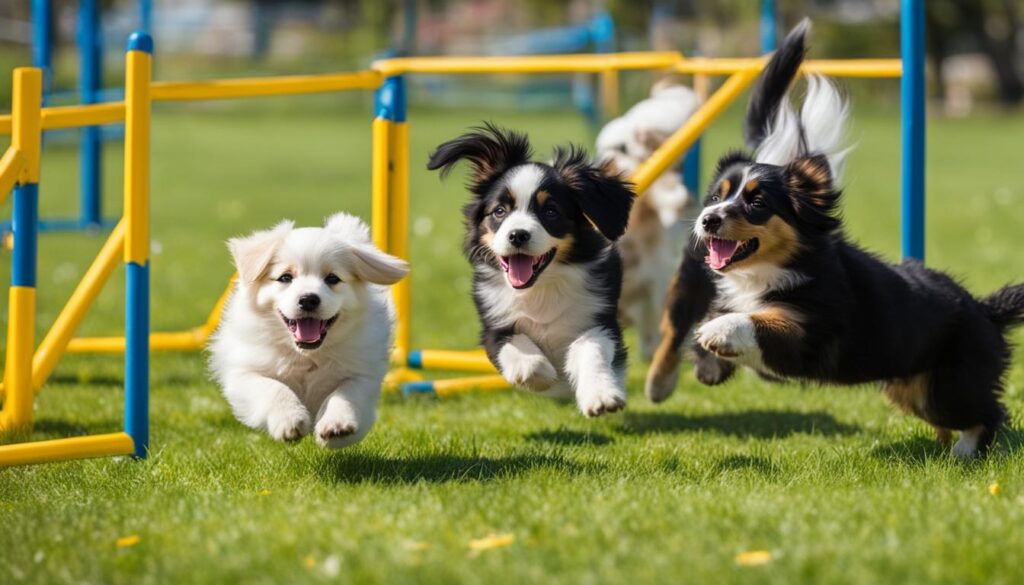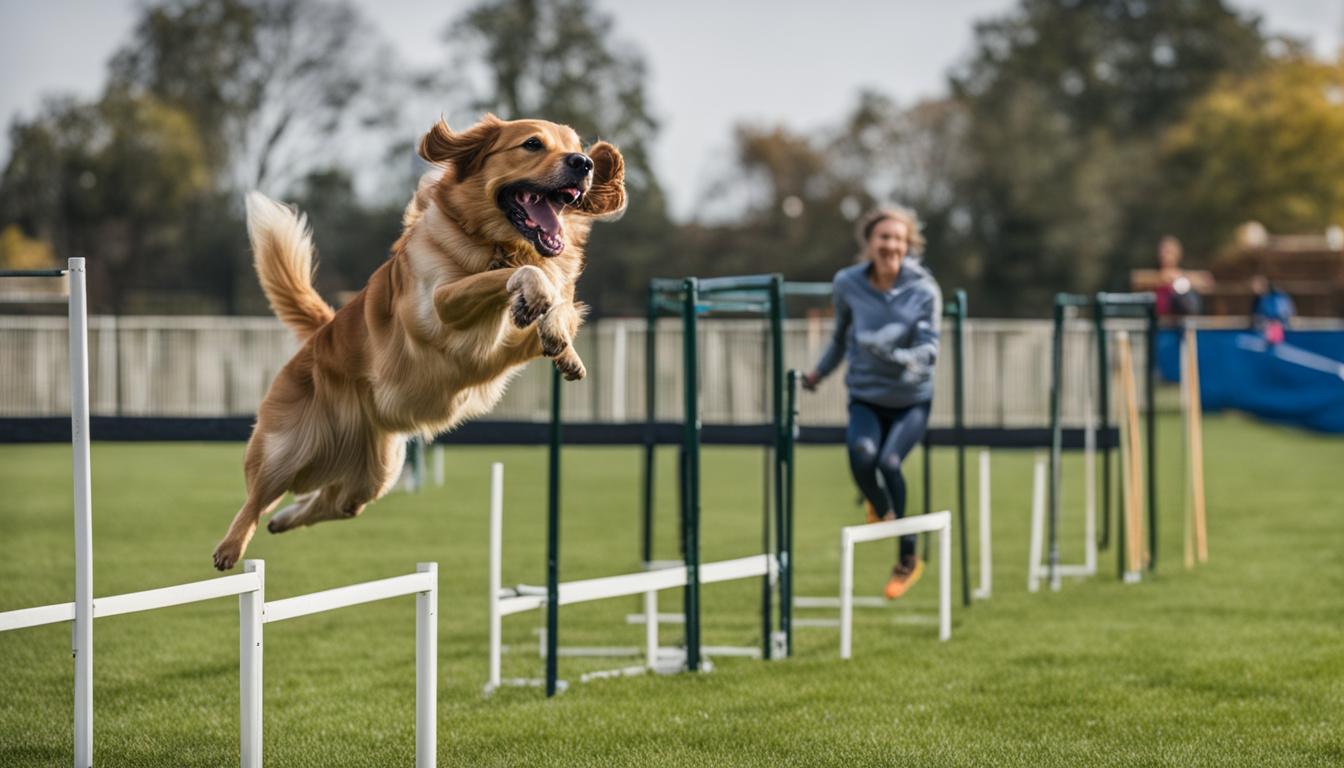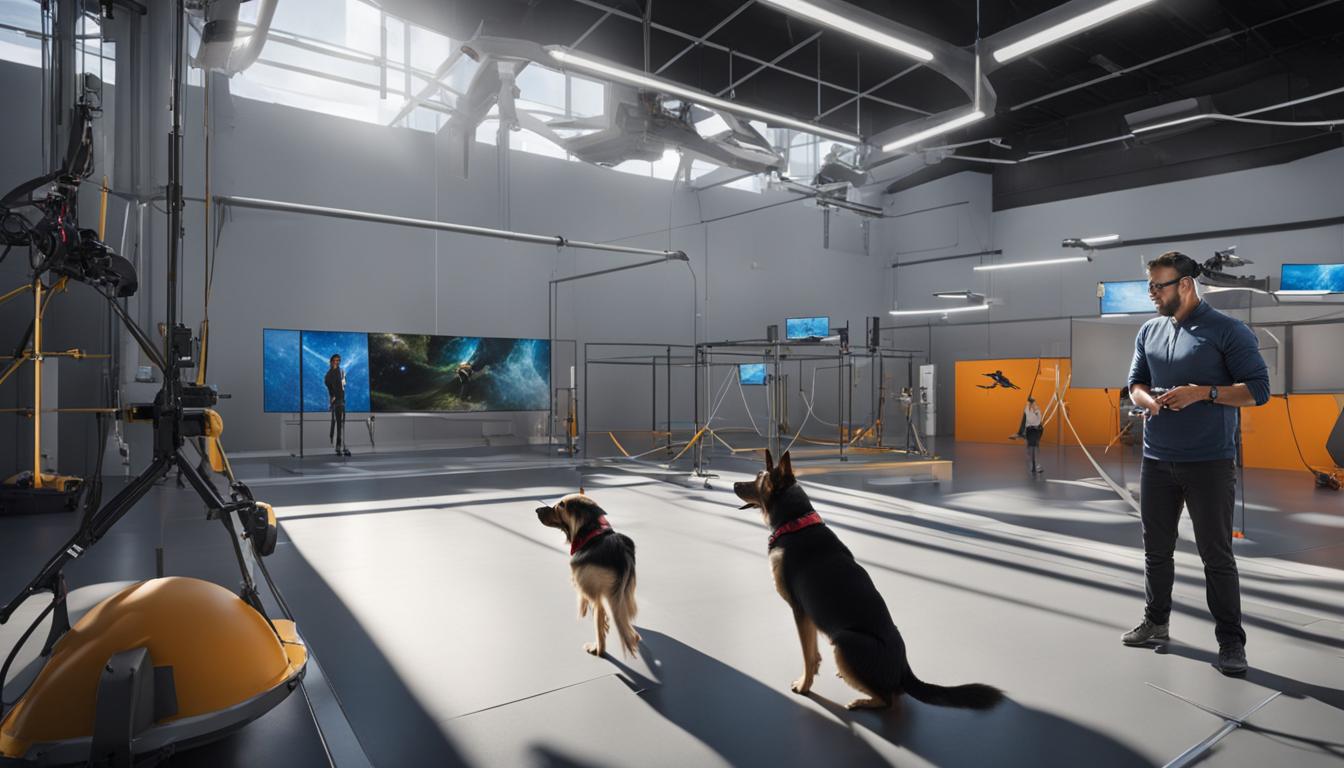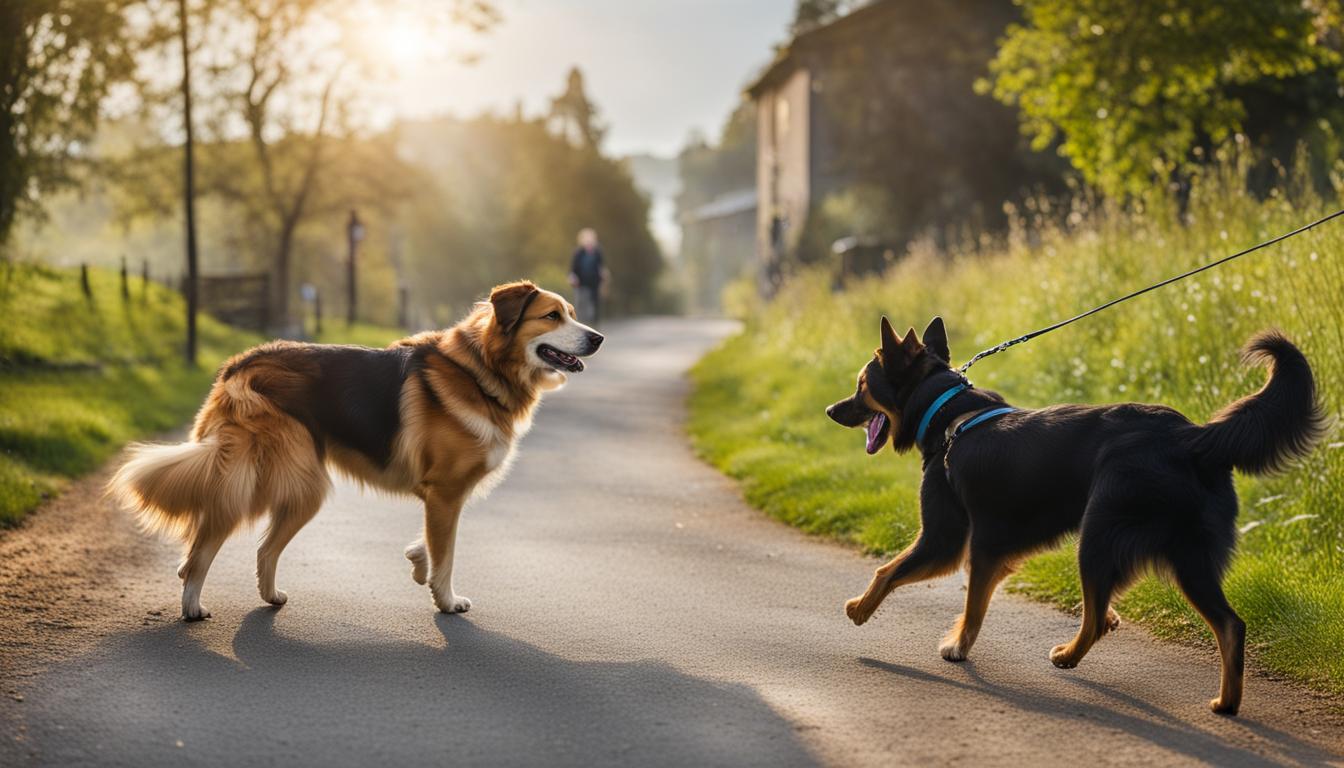Your furry friend is not just a playful companion but a keen learner too! Incorporating play into their training can be an incredibly effective way to reinforce positive behavior and build a stronger bond with your pup. Play-based learning techniques are not only fun but also highly engaging for dogs, helping them release energy, develop new skills, and gain confidence.
Key Takeaways:
- Play in dog training is a powerful tool to enhance obedience and address behavioral issues.
- By incorporating play as a reward, you can motivate your dog and make training sessions more exciting.
- There are various play-based training techniques, such as using toys, games, and interactive sessions.
- Puppies benefit greatly from playful training strategies, which aid in socialization and foundational learning.
- Timing, consistency, and observing your dog’s response are crucial for successful play-based training.
So, get ready to have some fun while training your furry friend! In this article, we’ll explore the benefits of incorporating play into dog training, the different techniques you can use, and why timing and consistency matter. Let’s dive in and discover how play can transform your training sessions into exciting adventures for both you and your pup!
Benefits of Play in Dog Training
Integrating play into dog training can have a multitude of benefits for both the dog and the owner. By using play as a reinforcing consequence for desired behaviors, you can enhance obedience and create a more enjoyable training experience. Play adds variety to training sessions, making them more exciting and unpredictable for your furry friend.
Play-based learning techniques are particularly effective in addressing behavioral issues. By using play as a training tool, you can redirect your dog’s focus and reinforce positive behavior. For example, playing tug-of-war can teach your dog self-control and provide an outlet for their high energy levels. This can be especially useful for dogs that are prone to destructive behavior when bored or anxious.
Using play to reinforce positive behavior is another valuable aspect of incorporating play into dog training. By rewarding your dog’s good behavior with playtime, you can strengthen the association between the desired behavior and the positive experience of play. This not only motivates your dog to repeat the behavior but also builds a stronger bond between you and your furry companion.

| Benefits of Playful Training Strategies | Tips for Successful Implementation |
|---|---|
| Enhances motivation and engagement | Keep training sessions short and fun |
| Strengthens the bond between you and your puppy | Use high-value rewards that your puppy finds enticing |
| Provides mental and physical stimulation | Observe your puppy’s preferences and adapt training accordingly |
| Reinforces desired behaviors | Incorporate play breaks and play-based socialization |
Importance of Timing and Consistency in Play-Based Training
When it comes to play-based training for dogs, timing and consistency are key factors that can greatly influence the effectiveness of the training sessions. Understanding how to properly time the rewards and maintain consistency throughout the training process is essential for achieving positive reinforcement and behavior modification.
In positive reinforcement, timing is crucial as it allows the dog to associate the reward with the desired behavior. The reward should be given immediately after the dog performs the desired behavior, reinforcing the connection between the action and the reward. This immediate association helps the dog understand what behavior is being rewarded and encourages them to repeat it in the future. So be sure to have those treats or toys ready to reward your furry friend at the right moment.
“Timing is everything in play-based training. You want to catch your dog in the act of doing something right and reward them promptly. This helps strengthen the desired behavior and teaches them what you expect.” – Dr. Amanda Richardson, Animal Behavior Specialist
Consistency is also vital in play-based training. This means using the same cues, rewards, and training methods consistently across different training sessions. Dogs thrive on routine and predictability, so maintaining consistency helps them understand what is expected of them and what will lead to rewards. It also helps prevent confusion and ensures that the desired behavior is consistently reinforced, reinforcing the positive behaviors you want to see from your dog.
The Impact of Timing and Consistency:
By carefully considering timing and consistency in play-based training, you can achieve better results and build a strong foundation for your dog’s behavior. Timely rewards help reinforce the desired behaviors, while consistency provides clarity and reinforces the expectations. When your dog understands the connection between their actions and the rewards, they become more engaged, motivated, and responsive during training sessions.
| Benefits of Timing in Positive Reinforcement | Importance of Consistency in Play-Based Training |
|---|---|
|
|
Remember, every dog is unique, so it’s important to observe and adapt your training approach based on your dog’s individual needs and preferences. Pay attention to their response to different rewards and adjust the timing and consistency accordingly. With the right balance of timing and consistency, play-based training can be a rewarding and enjoyable experience for both you and your furry companion.
Types of Rewards in Play-Based Training
When it comes to play-based training for dogs, rewards play a crucial role in reinforcing desired behaviors. The right choice of rewards can motivate and engage your dog, making the training sessions more effective and enjoyable. In play-based training, two common types of rewards are treats and toys.
Rewards: Treats
Treats are a popular choice for rewards in dog training as they tap into a dog’s food motivation. By using tasty treats, you can capture your dog’s attention and encourage them to perform the desired behavior. It is important to choose treats that are enticing and easily consumable, allowing for quick delivery and reinforcement. Some examples of dog treats for play-based training include small pieces of meat, dog-friendly biscuits, or soft chewy treats. Remember to use treats in moderation and consider your dog’s dietary needs and restrictions.
Rewards: Toys
Toys can also be a valuable reward in play-based training. They offer a different type of engagement for your dog and can be especially effective for dogs with a strong play drive. Interactive toys, such as puzzle toys or treat-dispensing toys, can provide mental stimulation and encourage problem-solving skills. Additionally, tug toys or balls can be used to reward your dog during training sessions, incorporating a fun and interactive element into the process. When using toys as rewards, it is important to choose ones that your dog finds exciting and enjoyable.
By using a combination of treats and toys as rewards, you can keep your dog engaged and motivated throughout the training session. It is important to vary the rewards to prevent boredom and to find what truly motivates your individual dog. Remember to observe how your dog responds to different rewards and adjust accordingly to ensure the training remains effective and enjoyable.

Next, we will explore the importance of observation and adaptation when it comes to play-based training. By paying attention to your dog’s responses and making necessary adjustments, you can create a training environment that is tailored to your dog’s preferences and needs.
Observation and Adaptation in Play-Based Training
Observing your dog’s response during training sessions is key to understanding their preferences and optimizing their learning experience. Every dog is unique, with different motivations and preferences when it comes to rewards and play. By paying close attention to their reactions, you can tailor the training sessions to suit their individual needs and ensure their enjoyment.
Dogs communicate through body language and vocalizations. Observe how they respond to different rewards and training techniques. Notice their excitement levels, body posture, and enthusiasm during play. This will help you gauge their engagement and motivation.
Adapting training sessions based on your dog’s response is crucial for long-term success. If you notice your dog losing interest or becoming overwhelmed, it’s important to adjust the session accordingly. This could involve shortening the duration of the training, changing the reward type or introducing new play-based activities to keep them engaged.
Creating a Positive Training Environment
Creating a positive training environment is essential for your dog’s enjoyment and engagement. Ensure that the training area is free from distractions and provides a comfortable space for play. Use positive reinforcement techniques, such as praise, treats, and play, to reward desired behaviors.
By observing your dog’s response and adapting the training sessions to their preferences, you can create a positive and enjoyable experience that strengthens the bond between you and your furry friend. Remember, training should be fun for both of you!
Conclusion
Incorporating play into your dog’s training is not only fun but also an effective way to reinforce positive behaviors and improve their overall behavior. By making training sessions playful, you can engage your dog’s natural instincts and provide them with the mental and physical stimulation they need.
Play adds variety and excitement to training sessions, keeping your dog motivated and eager to learn. Whether it’s using play as a reward, playing interactive games, or incorporating toys and treats, the element of play enhances the training experience for both you and your furry friend.
By observing your dog’s responses and adapting the training sessions to their preferences and needs, you can ensure that the training remains enjoyable and effective. Remember, the goal is to create a stronger bond between you and your dog while teaching them important skills and behaviors.
So, next time you embark on a training session with your canine companion, incorporate play for better behavior. It’s a playful and enjoyable approach that leads to successful training and a happier relationship with your furry best friend.
FAQ
Why is play important in dog training?
Play helps dogs release energy, learn new concepts, develop conflict resolution skills, improve motor skills, build self-control and confidence. It also adds variety to training sessions and strengthens the bond between owner and dog.
How does incorporating play into training sessions benefit dogs?
By using play as a reinforcing consequence for desired behaviors, dogs experience increased engagement, motivation, and enjoyment during training. Play adds excitement and unpredictability to lessons, can be used to address behavioral issues, and reinforces positive behavior.
What are some ways to incorporate play into training sessions?
Play can be used as a reward for completing behaviors successfully, playing tug-of-war to reinforce obedience commands, incorporating hide and seek games to practice different behaviors, and using toys or treats in interactive play sessions to keep dogs engaged and motivated.
How can play be incorporated into training sessions for puppies?
Puppies have a natural inclination for play, so it’s important to incorporate play into their training sessions. This can include play breaks, using toys or treats as rewards, play-based socialization with other puppies, and using play to reinforce desired behaviors and build a strong foundation for future training.
Why is timing crucial when using play as a reinforcement?
The reward should occur immediately after the behavior to ensure the dog associates it correctly. Consistency is also important, both in using the same cues and rewards across different training sessions and in consistently rewarding the desired behavior to avoid confusion.
What types of rewards can be used in play-based training?
Rewards can include food treats, praise, petting, or favorite toys or games. Food treats are often highly effective due to dogs’ food motivation. It’s important to choose enticing and easily consumable treats that can be delivered quickly.
How can you observe and adapt training sessions to fit the individual dog’s preferences and needs?
Pay attention to the dog’s response to rewards and overall training sessions. Not all dogs enjoy the same rewards, so it’s important to identify what motivates and excites the individual dog. Adapting sessions, reducing frequency or length, and ensuring both parties have a good time are key to successful play-based training.
What are the benefits of incorporating play into dog training?
Incorporating play into dog training is a fun and effective method to reinforce positive behaviors, address behavioral issues, and strengthen the bond between owner and dog. Play adds variety, engagement, and motivation to training sessions, making them more enjoyable for both parties.





